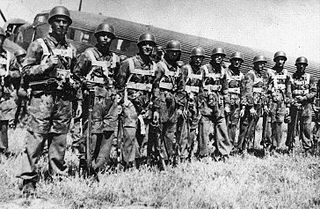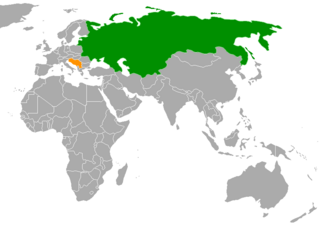
Josip Broz, commonly known as Tito, was a Yugoslav communist revolutionary and politician who served in various positions of national leadership from 1943 until his death in 1980. During World War II, he was the leader of the Yugoslav Partisans, often regarded as the most effective resistance movement in German-occupied Europe. He also served as the prime minister from 2 November 1944 to 29 June 1963 and president of the Socialist Federal Republic of Yugoslavia from 14 January 1953 until his death on 4 May 1980. Tito's political ideology and policies are collectively known as Titoism.
New class is a polemic term by critics of countries that followed the Soviet-type state socialism to describe the privileged ruling class of bureaucrats and Communist party functionaries which arose in these states. Generally, the group known in the Soviet Union as the nomenklatura conforms to the theory of the new class. The term was earlier applied to other emerging strata of the society. Milovan Đilas' new-class theory was also used extensively by anti-communist commentators in the Western world in their criticism of the Communist states during the Cold War.

The Informbiro period was an era of Yugoslavia's history following the Tito–Stalin split in mid-1948 that lasted until the country's partial rapprochement with the Soviet Union in 1955 with the signing of the Belgrade declaration. After World War II in Yugoslavia, Yugoslavia's new leadership under Josip Broz Tito pursued a foreign policy that did not align with the Eastern Bloc. Eventually, this led to public conflict, but the Yugoslav leadership decided not to acquiesce to Soviet demands, despite significant external and internal pressures. The period saw the persecution of the political opposition in Yugoslavia, resulting in thousands being imprisoned, exiled, or sent to forced labour. 100 Yugoslav citizens were seriously wounded or killed between 1948 and 1953 while some sources claim 400 victims during the existence of Goli otok prison camp. The purges included a significant number of members of Yugoslavia's security apparatus and its military.
The Anti-Fascist Council for the National Liberation of Yugoslavia, commonly abbreviated as the AVNOJ, was a deliberative and legislative body that was established in Bihać, Yugoslavia, in November 1942. It was established by Josip Broz Tito, the leader of the Yugoslav Partisans, an armed resistance movement led by the Communist Party of Yugoslavia to resist the Axis occupation of the country during World War II.

Milovan Djilas was a Yugoslav communist politician, theorist and author. He was a key figure in the Partisan movement during World War II, as well as in the post-war government. A self-identified democratic socialist, Djilas became one of the best-known and most prominent dissidents in Yugoslavia and all of Eastern Europe. During an era of several decades, he critiqued communism from the viewpoint of trying to improve it from within; after the revolutions of 1989 and the violent breakup of Yugoslavia, he critiqued it from an anti-communist viewpoint of someone whose youthful dreams had been disillusioned.

Vladimir "Vlatko" Velebit, PhD was a Yugoslav politician, diplomat and military leader who rose the rank of Major-General during World War II. A lawyer by profession, after the war he became a diplomat and historian.
The Tito–Stalin split or the Soviet–Yugoslav split was the culmination of a conflict between the political leaderships of Yugoslavia and the Soviet Union, under Josip Broz Tito and Joseph Stalin, respectively, in the years following World War II. Although presented by both sides as an ideological dispute, the conflict was as much the product of a geopolitical struggle in the Balkans that also involved Albania, Bulgaria, and the communist insurgency in Greece, which Tito's Yugoslavia supported and the Soviet Union secretly opposed.

The war crimes and crimes against humanity which were perpetrated by the Soviet Union and its armed forces from 1919 to 1991 include acts which were committed by the Red Army as well as acts which were committed by the country's secret police, NKVD, including its Internal Troops. In many cases, these acts were committed upon the orders of the Soviet leaders Vladimir Lenin and Joseph Stalin in pursuance of the early Soviet government's policy of Red Terror. In other instances they were committed without orders by Soviet troops against prisoners of war or civilians of countries that had been in armed conflict with the USSR, or they were committed during partisan warfare.
Two global superpowers, the Soviet Union (USSR) and the United States (US), rose in the aftermath of World War II. The war's aftermath was also defined by the rising threat of nuclear warfare, the creation and implementation of the United Nations as an intergovernmental organization, and the decolonization of Asia and Africa by European and east Asian powers, most notably by the United Kingdom, France, and Japan.

World War II in the Kingdom of Yugoslavia began on 6 April 1941, when the country was invaded and swiftly conquered by Axis forces and partitioned among Germany, Italy, Hungary, Bulgaria and their client regimes. Shortly after Germany attacked the USSR on 22 June 1941, the communist-led republican Yugoslav Partisans, on orders from Moscow, launched a guerrilla liberation war fighting against the Axis forces and their locally established puppet regimes, including the Axis-allied Independent State of Croatia (NDH) and the Government of National Salvation in the German-occupied territory of Serbia. This was dubbed the National Liberation War and Socialist Revolution in post-war Yugoslav communist historiography. Simultaneously, a multi-side civil war was waged between the Yugoslav communist Partisans, the Serbian royalist Chetniks, the Axis-allied Croatian Ustaše and Home Guard, Serbian Volunteer Corps and State Guard, Slovene Home Guard, as well as Nazi-allied Russian Protective Corps troops.

After the Munich Agreement, the Soviet Union pursued a rapprochement with Nazi Germany. On 23 August 1939 the Soviet Union signed a non-aggression pact with Germany which included a secret protocol that divided Eastern Europe into German and Soviet "spheres of influence", anticipating potential "territorial and political rearrangements" of these countries. Germany invaded Poland on 1 September 1939, starting World War II. The Soviets invaded eastern Poland on 17 September. Following the Winter War with Finland, the Soviets were ceded territories by Finland. This was followed by annexations of the Baltic states and parts of Romania.

The Syrmian Front was an Axis line of defense during World War II. It was established as part of the Eastern Front in late October 1944 in Syrmia and east Slavonia, northwest of Belgrade.

As Allied troops entered and occupied German territory during the later stages of World War II, mass rapes of women took place both in connection with combat operations and during the subsequent occupation of Germany by soldiers from all advancing Allied armies, although a majority of scholars agree that the records show that a majority of the rapes were committed by Soviet occupation troops. The wartime rapes were followed by decades of silence.
The subject of rape during the Soviet occupation of Poland at the end of World War II in Europe was absent from the postwar historiography until the dissolution of the Soviet Union, although the documents of the era show that the problem was serious both during and after the advance of Soviet forces against Nazi Germany in 1944–1945. The lack of research for nearly half a century regarding the scope of sexual violence by Soviet males, wrote Katherine Jolluck, had been magnified by the traditional taboos among their victims, who were incapable of finding "a voice that would have enabled them to talk openly" about their wartime experiences "while preserving their dignity." Joanna Ostrowska and Marcin Zaremba of the Polish Academy of Sciences wrote that rapes of the Polish women reached a mass scale during the Red Army's Winter Offensive of 1945.

Crimes against humanity under communist regimes occurred during the 20th century, including forced deportations, massacres, torture, forced disappearances, extrajudicial killings, terror, ethnic cleansing, and enslavement, as well as deliberate starvation of people. Additional events included the use of genocide, conspiracy to commit genocide, and complicity in genocide. Such events have been described as crimes against humanity.
Conversations with Stalin is a historical memoir by Yugoslav communist and intellectual Milovan Đilas. The book is an account of Đilas's experience of several diplomatic trips to Soviet Russia as a representative of the Yugoslav Communists. Writing in hindsight, Đilas recounts how his initial enthusiasms and feelings of ideological and ethnic brotherhood towards the Russian Communists were replaced by feelings of bitterness and disappointment following his repeated confrontations with the brutal, despotic reality of the Soviet regime under Joseph Stalin. Other figures which appear in the memoir include Josip Broz Tito, Aleksandar Ranković, and Edvard Kardelj of Yugoslavia, Vyacheslav Molotov, Ivan Stepanovich Konev, and Nikita Khrushchev of the Soviet Union, and Georgi Dimitrov of Bulgaria.

The Uprising in Montenegro, commonly known as the 13 July Uprising was an uprising against Italian occupation forces in Montenegro. Initiated by the Communist Party of Yugoslavia on 13 July 1941, it was suppressed within six weeks, but continued at a much lower intensity until Battle of Pljevlja on 1 December 1941. The insurgents were led by a combination of communists and former Royal Yugoslav Army officers from Montenegro. Some of the officers had recently been released from prisoner-of-war camps following their capture during the invasion of Yugoslavia. The communists managed the organisation and provided political commissars, while the insurgent military forces were led by former officers. The entire nation rejected the privileged position offered by its occupiers, rejected the capitulation in order to fight for Yugoslavia, together with "Russia".
Leftist errors was a term used by the Communist Party of Yugoslavia (CPY) to describe radical policies and strategies – described as the Red Terror by others – pursued by self-described left-wing elements among the party and partisan units during World War II, mostly in Montenegro, Herzegovina and Serbia, as well as to a lesser extent in Croatia and Slovenia.

The Stracin–Kumanovo operation was an offensive operation conducted in 1944 by the Bulgarian Army against German forces in occupied Yugoslavia which culminated in the capture of Skopje in 1944. With the Bulgarian declaration of war on Germany on September 8, followed by Bulgarian withdrawal from the area, the German 1st Mountain Division moved north, occupied Skopje, and secured the strategic Belgrade–Nis–Salonika railroad line. On October 14, withdrawing from Greece, Army Group E faced Soviet and Bulgarian divisions advancing in Eastern Serbia and Vardar Macedonia; by November 2, the last German units left Northern Greece.

Soviet Union–Yugoslavia relations were historical foreign relations between Soviet Union and Yugoslavia. Both states are now-defunct states with dissolution of the Soviet Union from 1988 through 1991 and breakup of Yugoslavia from 1991 through 1992. Relations between the two countries developed very ambiguously. Until 1940 they were openly hostile, in 1948 they deteriorated again and in 1949 were completely broken. In 1953–1955 period, bilateral relations were restored with the signing of Belgrade declaration, but until the collapse of Yugoslavia they remained very restrained. Relations with Soviet Union were of high priority for Belgrade as those relations or their absence helped the country to develop the principle of Cold War equal-distance on which the Yugoslav non-alignment policy was based.












